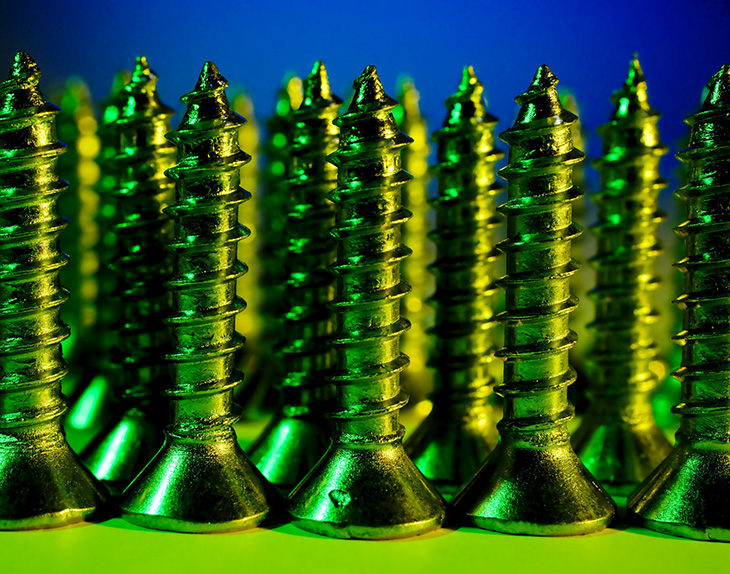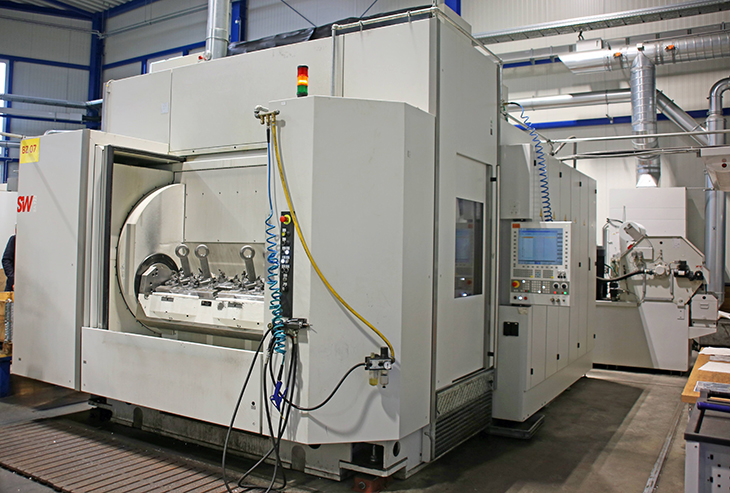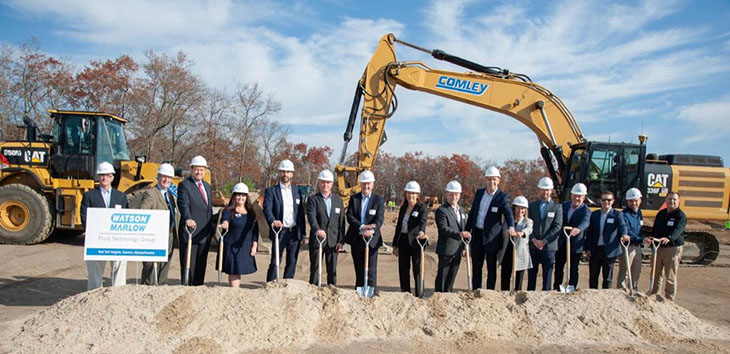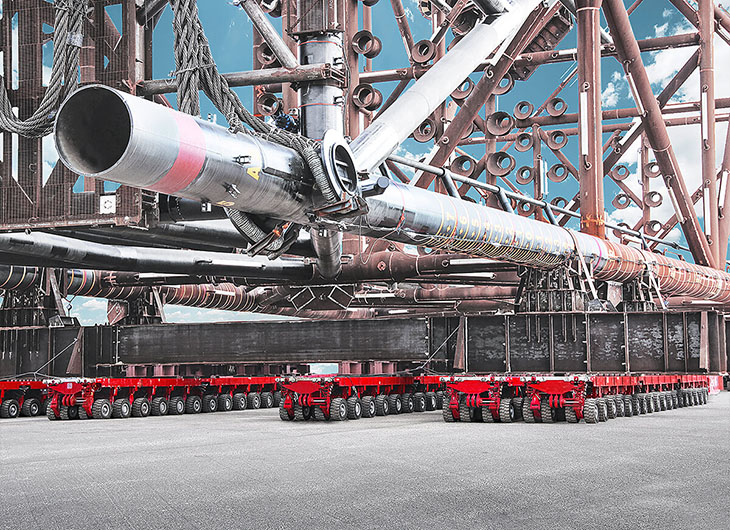New stretch-bend-levelling line for very thin copper strips is energy-efficient and operates with minimal tolerances
Convenient operating concept with automatic feed-in system
Flatness requirements for metal strips have increased steadily in recent years. At the same time there is a trend - particularly in the electronics industry - towards increasingly thinner materials. Here, quality improvements through stretch-bend-levelling facilitate further processing considerably. As a result, e.g. dimensional accuracy is increased in the stamping process and thinner surface coatings can be achieved. Hence, the cutting and levelling machine specialist Burghardt + Schmidt GmbH (B+S) developed an innovative solution for the levelling of extremely thin copper strips for a Chinese manufacturer. The line is suited for all alloys of the material as well as for phosphor bronze, and allows strips just 30 µm thick to be processed with minimal tolerances. Depending on the starting material, flatnesses down to one I-unit can be achieved.
The client in China manufactures parts for the electronics industry that need to satisfy exacting requirements with regard to surface quality as well as flatness or dimensional accuracy. In this case, extremely thin metal strips are used. At a plant to be redesigned, these are to be prepared for further processing. The aim of the new purchase was to keep the shape tolerance within tight limits during the stamping process. This is vitally important in regard to the automated assembly of electronic components. Besides flatness, the client also defined exclusion criteria relating to the surface quality. This means that the optical density of the end product should not be changed through the processing.
"Given the clearly recognisable trend for ever thinner strips, the B+S lines constantly reach their control limits. Due to customer requirements as well as the results of corresponding market analyses, we have therefore pressed ahead with basic developments for some time. These generally allow the levelling of metal strips that are just 20 µm thick," explains Volker Lüdecke, technical manager at B+S. The concept presented and the company's extensive experience in stretch-bend-levelling was ultimately the decisive factors in winning the contract from China.
Cassette with 8 mm levelling rollers
For the build-up of tension, the line has four rollers on the braking side, that is, in front of the levelling machine. Around these rollers runs the metal strip. And together with the decoiler, they generate the back tension. Behind the levelling machine the four tension rollers, together with the recoiler, pull on the strip. By means of force superposition (tension and bending) between the groups of upper and lower levelling rollers, the internal tensions and shape deviations of the strips are reduced. To achieve a sufficient levelling effect in the case of very thin strips with material thicknesses of between 30 and 200 µm, the metal strip specialist has developed a cassette with a levelling roller diameter of 8 mm. For thicknesses greater than 200 µm, 12 mm levelling rollers are used.
Deviations are automatically detected by a Vollmer shapemeter roll for continuous strip shape measurement. Strip zones with waves exert less force on the segmented roller than flat strip zones. A software calculates the mathematical formula for the strip shape with the help of the measured values and uses this to create a 3D model. Based on this, the necessary position of the levelling roller supports can be calculated and automatically adjusted. Manual readjustment is unnecessary. A special feature are the four adjusting axles at the upper levelling cassette, which ensure the ultra-precise position of the three spatial axes. "Depending on the initial flatness, evennesses down to one I-unit can thus be achieved. This corresponds to a 0.2 mm high and 100 mm long wave in the strip", explains Lüdecke.
Highly dynamic drive for broad control spectrum
In principle, all copper alloys are processed on the line without restrictions, with the strips having a wide range of cross-sections and the tensile strength of the material varying between 300 and 1,100 N/mm². The thickness thus lies between 30 and 500 µm and the width is between 100 and 450 mm, which results in an aspect ratio of 1 : 75. If the yield strength of 200 to 1,050 N/mm² is added, the ratio to be controlled for is 1 : 390. Due to this wide spectrum, the strip tension is measured directly at the decoiler and recoiler as well as in front of the levelling machine and serves as a control value for the drives. These are equipped with highly dynamic AC motors.
The installed capacity here amounts to around 550 kW. "Feed-in is performed with Sinamics S120 Basic Line assemblies, so that the regenerative energy can be reused via an energetic recovery system on the pull side ̶ that is, for the motors after the levelling machine. This leads to significant energy savings," explains Lüdecke, thus pointing out one of the main advantages of the line. Activation is performed by fully digitalised inverters, which are coupled to the PLC of the line controller via Profibus L2-DP. The actual control functions are controlled via a microprocessor that enables not only considerable ease of operation but also easy start-up and maintenance.
Especially user-friendly and safe operating concept
The complete line bears the CE sign and is designed in accordance with the European Machinery Directive 2006/42/EC, which provides for, among other things, a protective fence for employee safety. The existence of several protective areas means that activities can already be performed by the operator in one of them while automatic movements are still taking place in the other. When such a sub-area is opened, the speed there is automatically reduced to a safe level. "In addition, due to the spatial arrangement of the consoles, a sufficient distance to the moving machine parts and the strip is ensured by design", says Lüdecke. The normal length of time until standstill is 12 s, but this can be reduced to 6 s or, in the case of emergency, even to 3 s if required.
From the operator's point of view, the material runs from left to right through the installation at a speed of up to 300 m/min. The individual process steps are visualised by means of overview and detailed images. The operator can perform his input directly via buttons and data fields in the images or via pop-up windows. The axle positions typical for the materials can be stored as individual data sets with alphanumeric names in a database. Customer-specific order management can also be integrated into the system. Connection to the company's network ensures that the operator can access his current production plan at all times. During a cassette change, the system recognises by means of an identification system which cassette is currently installed. Manual, time-consuming readjustment is no longer necessary. By means of further automatic systems, for example in the form of an automatic coil and spool transport, parallel activities can be performed. As a result, what previously took two men to do can now be undertaken by a single employee.
A feed-in system developed by B+S also contributes to economic efficiency and convenience: In this case, the strip to be processed is mounted as usual in the form of a coil onto the decoiler. Manual feed, however, is not necessary. Instead, the beginning of the strip is clamped in a clamping bar at the beginning of the line and pulled through to the outfeed at a speed of 10 to 15 m/min. This means that no pilot strip is required and welding or the need for guide plates is eliminated.
Initial winding on the recoiler also takes place automatically with a belt wrapper. "The productivity of the line is increased, since the actual processing can be started quickly and efficiently", sums up the technical manager. To ensure that the strip is wound up neatly at the end, the decoiler and recoiler are also each equipped with a strip edge controller. The reels, each weighing six tons, stand on linear guideways that are pre-loaded, free of play and mounted on anti-friction bearings. Together with the edge detection and position control, the reels ensure precise unwinding and winding via a servo-hydraulically controlled hydraulic cylinder.
(further information on the Internet: www.b-s-germany.de)

























